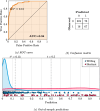Modifiable risk factors of vaccine hesitancy: insights from a mixed methods multiple population study combining machine learning and thematic analysis during the COVID-19 pandemic
- PMID: 40075423
- PMCID: PMC11905715
- DOI: 10.1186/s12916-025-03953-y
Modifiable risk factors of vaccine hesitancy: insights from a mixed methods multiple population study combining machine learning and thematic analysis during the COVID-19 pandemic
Abstract
Background: Vaccine hesitancy, the delay in acceptance or reluctance to vaccinate, ranks among the top threats to global health. Identifying modifiable factors contributing to vaccine hesitancy is crucial for developing targeted interventions to increase vaccination uptake.
Methods: This mixed-methods multiple population study utilized gradient boosting machines and thematic analysis to identify modifiable predictors of vaccine hesitancy during the COVID-19 pandemic. Predictors of vaccine hesitancy were investigated in 2926 Norwegian adults (Mage = 37.91, 79.69% female), before the predictive utility of these variables was investigated in an independent sample of 734 adults in the UK (Mage = 40.34, 57.08% female). Two independent teams of authors conducted the machine learning and thematic analyses, blind to each other's analytic procedures and results.
Results: The machine learning model performed well in discerning vaccine hesitant (n = 248, 8.48% and n = 109, 14.85%, Norway and UK, respectively) from vaccine uptaking individuals (n = 2678, 91.52% and n = 625, 85.15%), achieving an AUC of 0.94 (AUPRC: 0.72; balanced accuracy: 86%; sensitivity = 0.81; specificity = 0.98) in the Norwegian sample, and an AUC of 0.98 (AUPRC: 0.89; balanced accuracy: 89%; sensitivity = 0.83; specificity = 0.97) in the out-of-sample replication in the UK. The mixed methods investigation identified five categories of modifiable risk tied to vaccine hesitancy, including illusion of invulnerability, doubts about vaccine efficacy, mistrust in official entities, minimization of the societal impact of COVID-19, and health-related fears tied to vaccination. The portrayal of rare incidents across alternative media platforms as fear amplifiers, and the mainstream media's stigmatizing presentation of unvaccinated individuals, were provided as additional motives underlying vaccine reluctance and polarization. The thematic analysis further revealed information overload, fear of needles, previous negative vaccination experiences, fear of not getting healthcare follow-up after vaccination if needed, and vaccine aversion due to underlying (psychiatric) illness (e.g., eating disorders) as motives underlying vaccine hesitance.
Conclusions: The identified influential predictors were consistent across two European samples, highlighting their generalizability across European populations. These predictors offer insights about modifiable factors that could be adapted by public health campaigns in mitigating misconceptions and fears related to vaccination toward increasing vaccine uptake. Moreover, the results highlight the media's responsibility, as mediators of the public perception of vaccines, to minimize polarization and provide accurate portrayals of rare vaccine-related incidents, reducing the risk aggravating fear and reactance to vaccination.
Keywords: COVID-19; Extreme Gradient Boosting (XGBoost); General adult population; Machine learning; Mixed methods study; Pandemic; Thematic analysis; Vaccine hesitancy.
© 2025. The Author(s).
Conflict of interest statement
Declarations. Ethics approval and consent to participate: This study was ethically approved by The Norwegian Regional Committee for Medical and Health Research Ethics (REK; reference: 125510) and the Norwegian Centre for Research Data (NSD; reference: 802810). All participants provided their consent for their data to be used in this research. Consent for publication: Not applicable. Competing interests: The authors declare no competing interests.
Figures



References
-
- WHO. Ten threats to global health in 2019. Available from: https://www.who.int/news-room/spotlight/ten-threats-to-global-health-in-....
-
- Dubé È, Ward JK, Verger P, MacDonald NE. Vaccine hesitancy, acceptance, and anti-vaccination: trends and future prospects for public health. Annu Rev Public Health. 2021;42:175–91. - PubMed
-
- MacDonald NE. Vaccine hesitancy: definition, scope and determinants. Vaccine. 2015;33:4161–4. - PubMed
-
- Obregon R, Mosquera M, Tomsa S, Chitnis K. Vaccine hesitancy and demand for immunization in Eastern Europe and Central Asia: implications for the region and beyond. J Health Commun. 2020;25:808–15. - PubMed
-
- Ryan J, Malinga T. Interventions for vaccine hesitancy. Curr Opin Immunol. 2021;71:89–91. - PubMed
MeSH terms
Substances
Grants and funding
LinkOut - more resources
Full Text Sources
Medical

